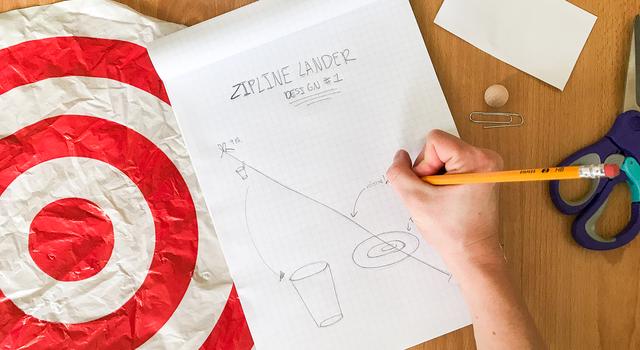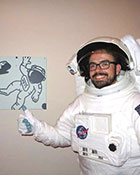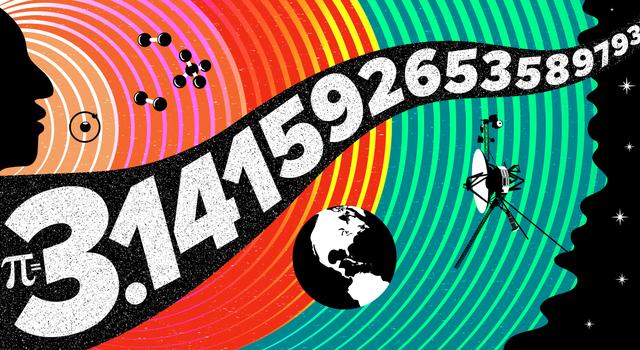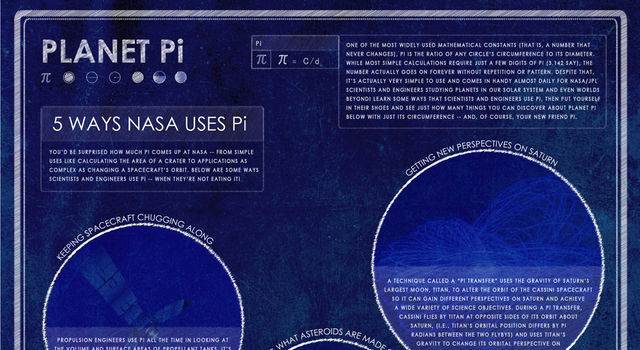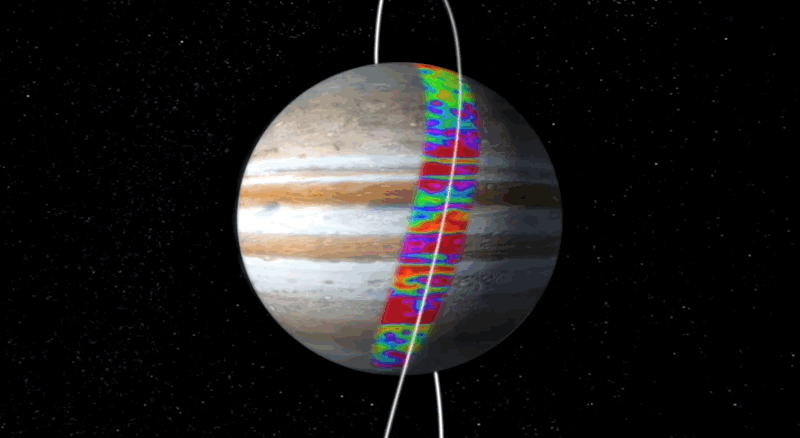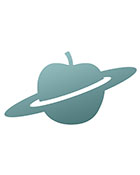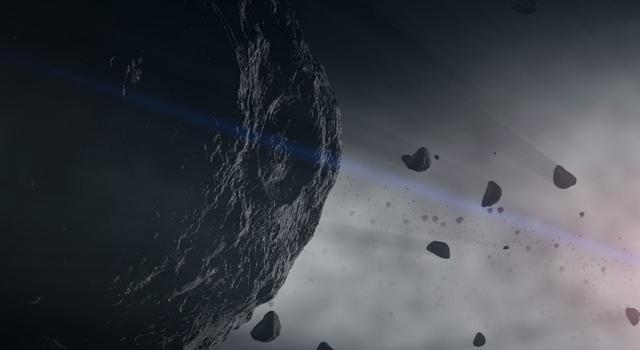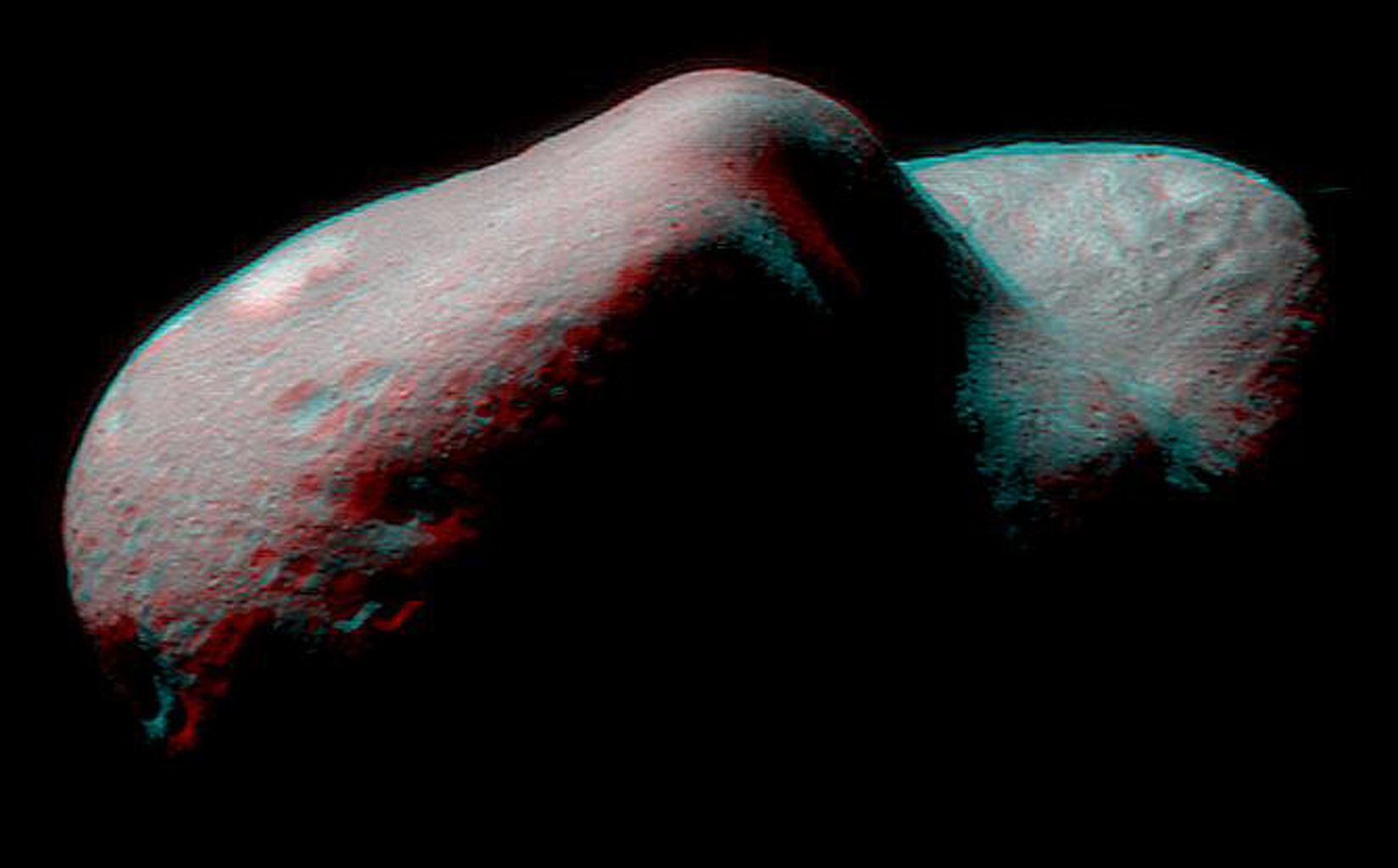Teachable Moments | April 28, 2023
May the Force = mass x acceleration
Science fiction meets science fact in this Star Wars inspired Teachable Moment all about ion propulsion and Newton’s Laws.
In the News
What do "Star Wars," NASA's Dawn spacecraft and Newton's Laws of Motion have in common? An educational lesson that turns science fiction into science fact using spreadsheets – a powerful tool for developing the scientific models addressed in the Next Generation Science Standards. Keep reading to learn more and find out how to get students wielding the force.
Why It's Important
The TIE (Twin Ion Engine) fighter is a staple of the "Star Wars" universe. Darth Vader flew one in "A New Hope." Poe Dameron piloted one in "The Force Awakens." And many, many Imperial pilots met their fates in them. While the fictional TIE fighters in "Star Wars" flew a long time ago in a galaxy far, far away, ion engines are a reality in this galaxy today – and have a unique connection to NASA’s Jet Propulsion Laboratory.
Launched in 1998, the first spacecraft to use an ion engine was Deep Space 1, which flew by asteroid 9969 Braille and comet Borrelly. Fueled by the success of Deep Space 1, engineers at JPL set forth to develop the next spacecraft that would use ion propulsion. This mission, called Dawn, would take ion-powered spacecraft to the next level by allowing Dawn to go into orbit twice – around the two largest objects in the asteroid belt: Vesta and Ceres.
How It Works
Ion engines rely on two principles that Isaac Newton first described in 1687. First, a positively charged atom (ion) is pushed out of the engine at a high velocity. Newton’s Third Law of Motion states that for every action there is an equal and opposite reaction, so then a small force pushes back on the spacecraft in the opposite direction – forward! According to Newton’s Second Law of Motion, there is a relationship between the force (F) exerted on an object, its mass (m) and its acceleration (a). The equation F=ma describes that relationship and tells us that the small force applied to the spacecraft by the exiting atom provides a small amount of acceleration to the spacecraft. Push enough atoms out, and you'll get enough acceleration to really speed things up.
Why is It Important?
Compared with traditional chemical rockets, ion propulsion is faster, cheaper and safer:
- Faster: Spacecraft powered by ion engines can reach speeds of up to 90,000 meters per second (more than 201,000 mph!)
- Cheaper: When it comes to fuel efficiency, ion engines can reach more than 90 percent fuel efficiency, while chemical rockets are only about 35 percent efficient.
- Safer: Ion thrusters are fueled by inert gases. Most of them use xenon, which is a non-toxic, chemically inert (no risk of exploding), odorless, tasteless and colorless gas.
These properties make ion propulsion a very attractive solution when engineers are designing spacecraft. While not every spacecraft can use ion propulsion – some need greater rates of acceleration than ion propulsion can provide – the number and types of missions using these efficient engines is growing. In addition to being used on the Dawn spacecraft and communication satellites orbiting Earth, ion propulsion could be used to boost the International Space Station into higher orbits and will likely be a part of many future missions exploring our own solar system.
Teach It
Newton’s Laws of Motion are an important part of middle and high school physical science and are addressed specifically by the Next Generation Science Standards as well as Common Core Math standards. The lesson "Ion Propulsion: Using Spreadsheets to Model Additive Velocity" lets students study the relationship between force, mass and acceleration as described by Newton's Second Law as they develop spreadsheet models that apply those principles to real-world situations.
Educator Guides
-
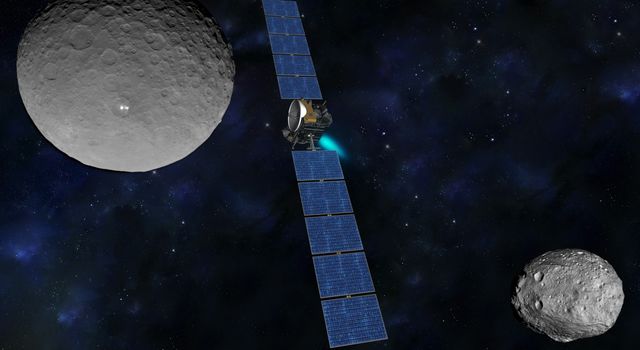
Using Spreadsheets to Model Additive Velocity
Students develop spreadsheet models that describe the relationship between the mass of a spacecraft, the force acting on the craft, and its acceleration.
Grades 6-12
Time 30-60 mins
-
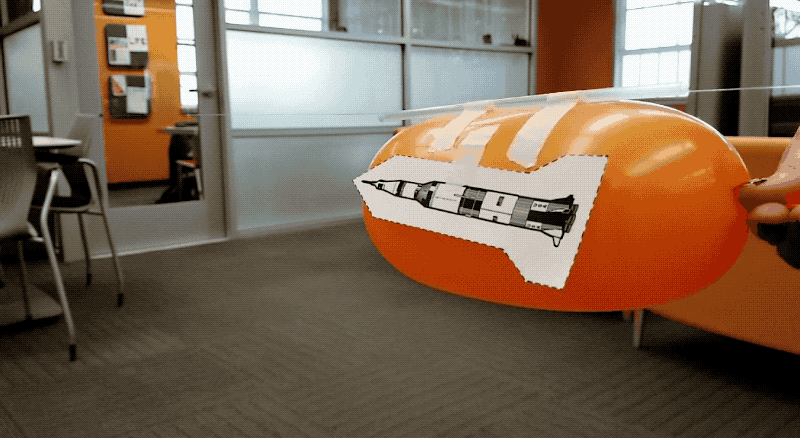
Motion and Forces Lessons
Get students wielding "the force" with these standards-aligned lessons all about motion and forces.
Grades K-12
Time Varies
Student Activities
Explore More
- Website: Dawn Mission
- Blog: Dawn Journal
- Video: Crazy Engineering - Ion Propulsion
- Ion propulsion interactives
- Eyes on the Solar System: Dawn Mission Tour (scroll to "Solar System Tours" and click the "Dawn" link)
This feature was originally published on May 3, 2016.
TAGS: May the Fourth, Star Wars Day, F=ma, ion propulsion, Dawn, Deep Space 1, lesson, classroom activity, NGSS, Common Core Math
Edu News | October 24, 2022
How Many Decimals of Pi Do We Really Need?
While world record holders may have memorized more than 70,000 digits of pi, a JPL engineer explains why you really only need a tiny fraction of that for most calculations – even at NASA.
Update: October 24, 2022 – This article, originally written in 2016, has been updated to reflect the latest values for NASA’s Voyager 1 spacecraft, which continues to venture farther into interstellar space. The author, Marc Rayman, has ventured on too, from the chief engineer for NASA’s Dawn mission, which concluded successfully in 2018, to the chief engineer for mission operations and science at NASA’s Jet Propulsion Laboratory.

This graphic shows more than 500 of the infinite number of decimals in pi. Image credit: NASA/JPL-Caltech | + Expand image
We received this question from a fan on Facebook who wondered how many decimals of the never-ending mathematical constant pi (π) NASA-JPL scientists and engineers use when making calculations:
“Does JPL only use 3.14 for its pi calculations? Or do you use more decimals, like say [360 or even more]?”
Here’s JPL’s Chief Engineer for Mission Operations and Science, Marc Rayman, with the answer:
Thank you for your question! This isn't the first time I've heard a question like this. In fact, it was posed many years ago by a sixth-grade science and space enthusiast who was later fortunate enough to earn a doctorate in physics and become involved in space exploration. His name was Marc Rayman.
To start, let me answer your question directly. For JPL's highest accuracy calculations, which are for interplanetary navigation, we use 3.141592653589793. Let's look at this a little more closely to understand why we don't use more decimal places. I think we can even see that there are no physically realistic calculations scientists ever perform for which it is necessary to include nearly as many decimal points as you asked about. Consider these examples:
- The most distant spacecraft from Earth is Voyager 1. As of this writing, it’s about 14.7 billion miles (23.6 billion kilometers) away. Let’s be generous and call that 15 billion miles (24 billion kilometers). Now say we have a circle with a radius of exactly that size, 30 billion miles (48 billion kilometers) in diameter, and we want to calculate the circumference, which is pi times the radius times 2. Using pi rounded to the 15th decimal, as I gave above, that comes out to a little more than 94 billion miles (more than 150 billion kilometers). We don't need to be concerned here with exactly what the value is (you can multiply it out if you like) but rather what the error in the value is by not using more digits of pi. In other words, by cutting pi off at the 15th decimal point, we would calculate a circumference for that circle that is very slightly off. It turns out that our calculated circumference of the 30-billion-mile (48-billion-kilometer) diameter circle would be wrong by less than half an inch (about one centimeter). Think about that. We have a circle more than 94 billion miles (more than 150 billion kilometers) around, and our calculation of that distance would be off by no more than the width of your little finger.
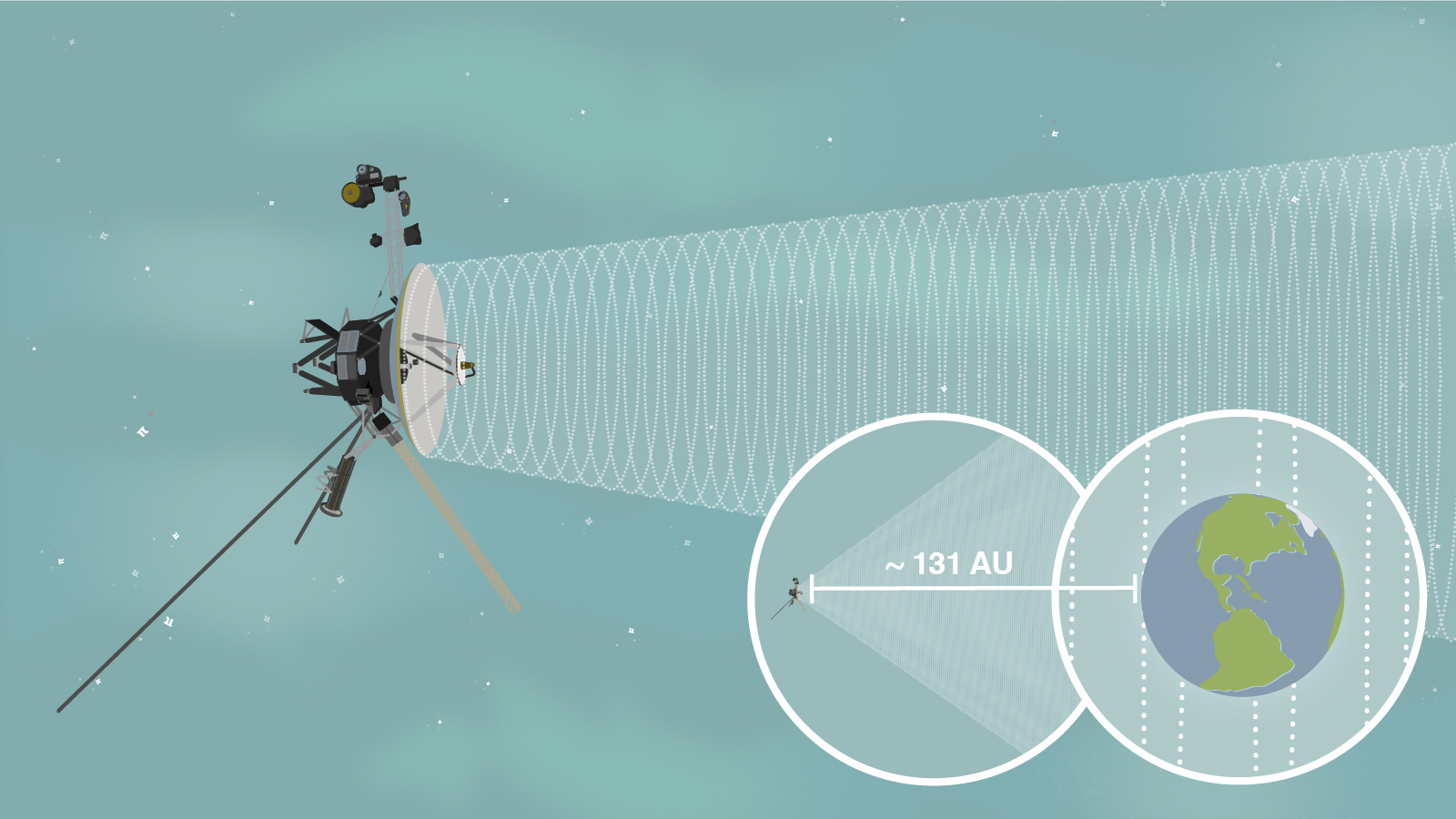
Put your pi math skills to the test with this problem from NASA's Pi Day Challenge. Can you use pi to determine what fraction of a signal from Voyager 1 reaches Earth? Image credit: NASA/JPL-Caltech | + Expand image | › View lesson page
- We can bring this closer to home by looking at our planet, Earth. It is more than 7,900 miles (12,700 kilometers) in diameter at the equator. The circumference is roughly 24,900 miles (40,100 kilometers). That's how far you would travel if you circumnavigated the globe – and didn't worry about hills, valleys, and obstacles like buildings, ocean waves, etc. How far off would your odometer be if you used the limited version of pi above? The discrepancy would be the size of a molecule. There are many different kinds of molecules, of course, so they span a wide range of sizes, but I hope this gives you an idea. Another way to view this is that your error by not using more digits of pi would be more than 30,000 times thinner than a hair!

Image credit: NASA | + Expand image
- Let's go to the largest size there is: the known universe. The radius of the universe is about 46 billion light years. Now let me ask (and answer!) a different question: How many digits of pi would we need to calculate the circumference of a circle with a radius of 46 billion light years to an accuracy equal to the diameter of a hydrogen atom, the simplest atom? It turns out that 37 decimal places (38 digits, including the number 3 to the left of the decimal point) would be quite sufficient. Think about how fantastically vast the universe is. It’s certainly far beyond what you can see with your eyes even on the darkest, most beautiful night of sparkling stars. It’s yet farther beyond the extraordinary vision of the James Webb Space Telescope. And the vastness of the universe is truly far, far, far beyond what we can even conceive. Now think about how incredibly tiny a single atom is. Isn’t it amazing that we wouldn’t need to use many digits of pi at all to cover that entire unbelievable range?
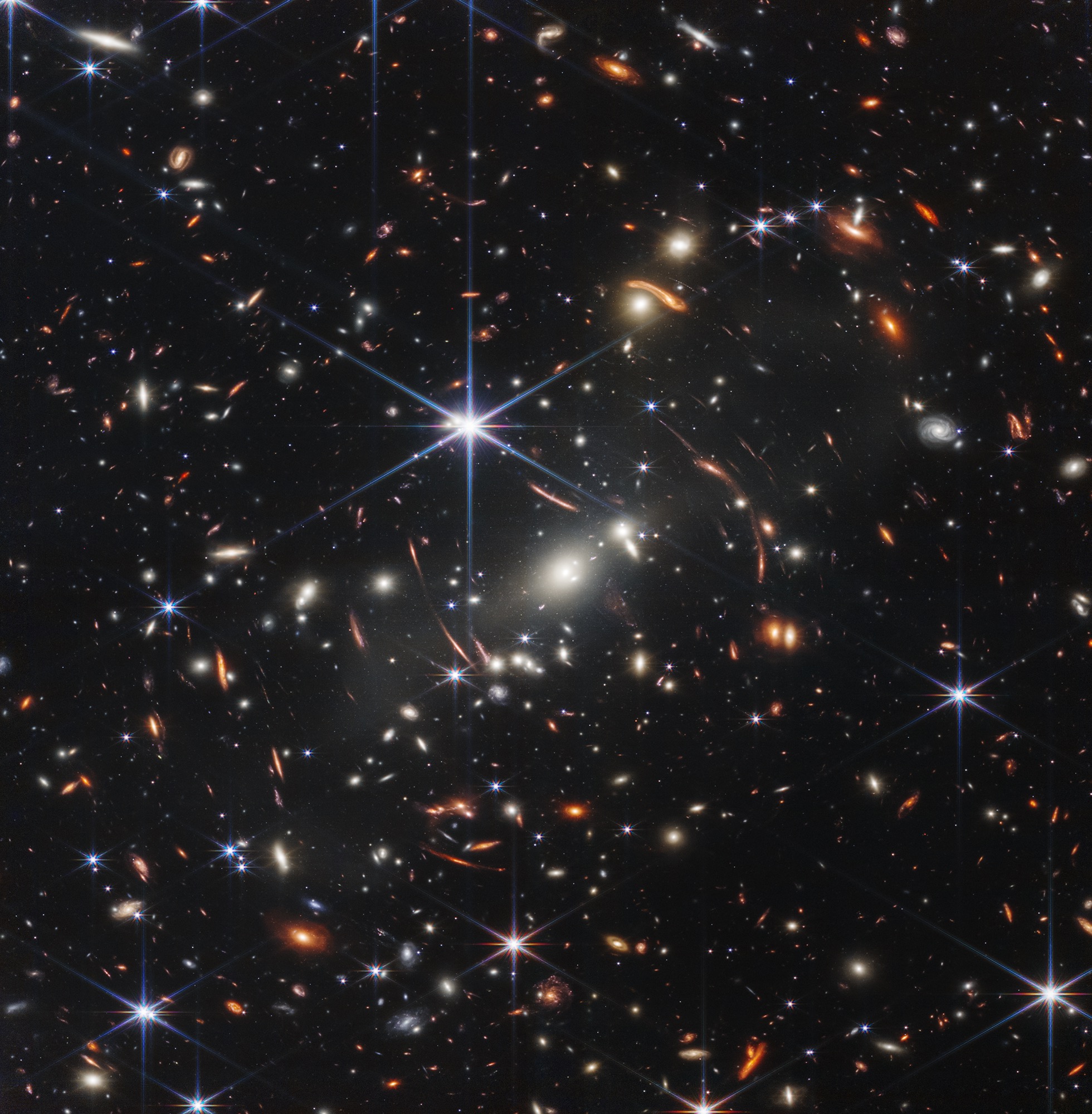
If you were to hold a single grain of sand at arm's length, you could cover the entire area of space taken up by this image, which was captured by the James Webb Space Telescope and contains thousands of galaxies. The oldest-known galaxy identified in the image is 13.1 billion years old. Image credit: NASA, ESA, CSA, STScI | + Expand image | › More about the image | Text description (PDF)
Pi is an intriguing number with interesting mathematical properties. It’s fun to think about its truly endless sequence of digits, and it may be surprising how often it appears in the equations scientists and engineers use. But there are no questions – prosaic or esoteric – in humankind’s noble efforts to explore or comprehend the marvels of the cosmos, from the unimaginably smallest scales to the inconceivably largest, that could require very many of those digits.
Hear more from Marc in his inspiring TEDx talk, “If It Isn’t Impossible, It Isn’t Worth Trying” and in his Dawn Journal, where he wrote frequent updates about the Dawn mission’s extraordinary extraterrestrial expedition to the protoplanet Vesta and dwarf planet Ceres.
Explore More
Educator Resources
-
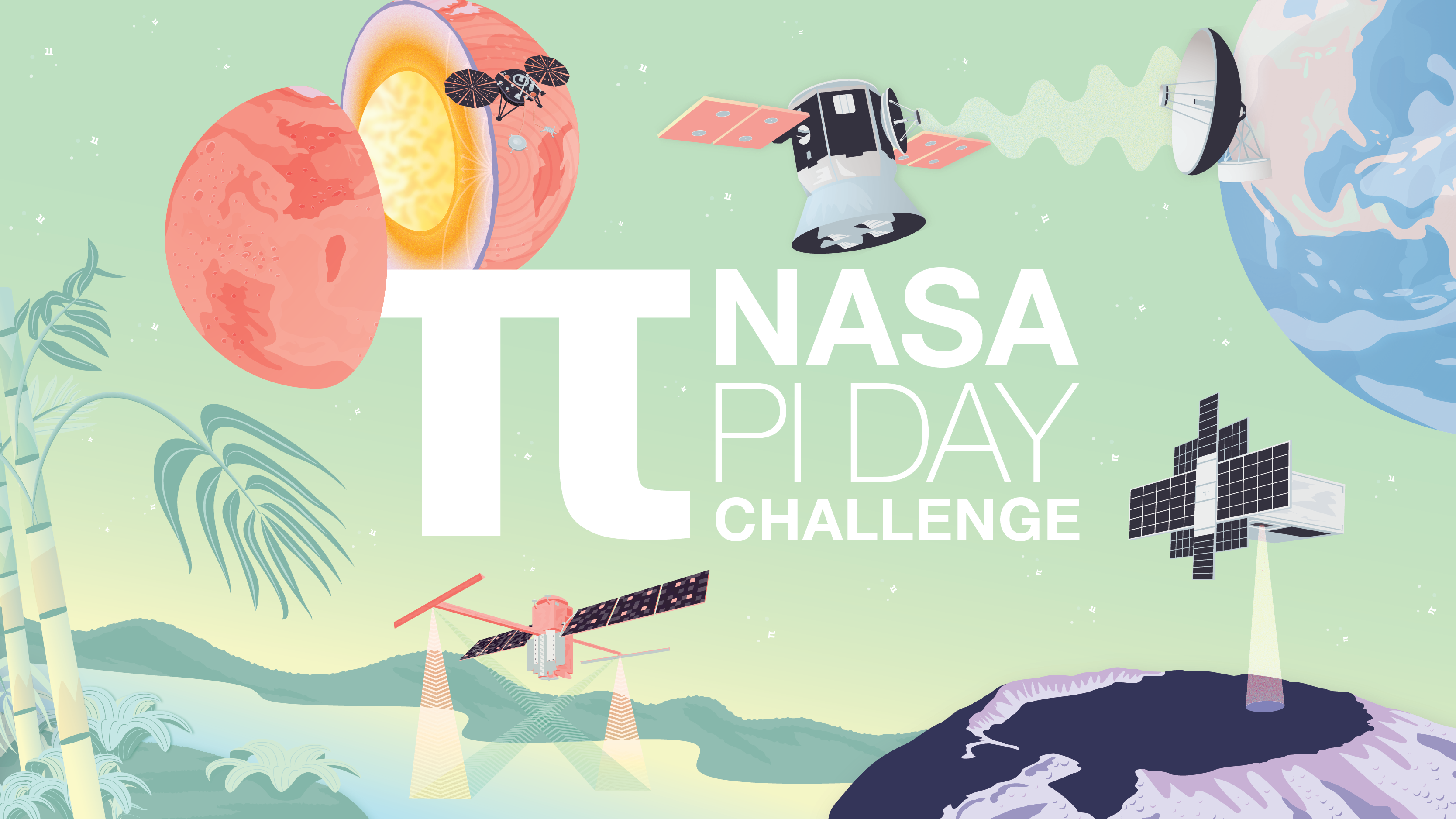
NASA Pi Day Challenge
This collection of illustrated math problems gets students using pi like NASA scientists and engineers exploring Earth and space.
Grades 4-12
Time Varies
-
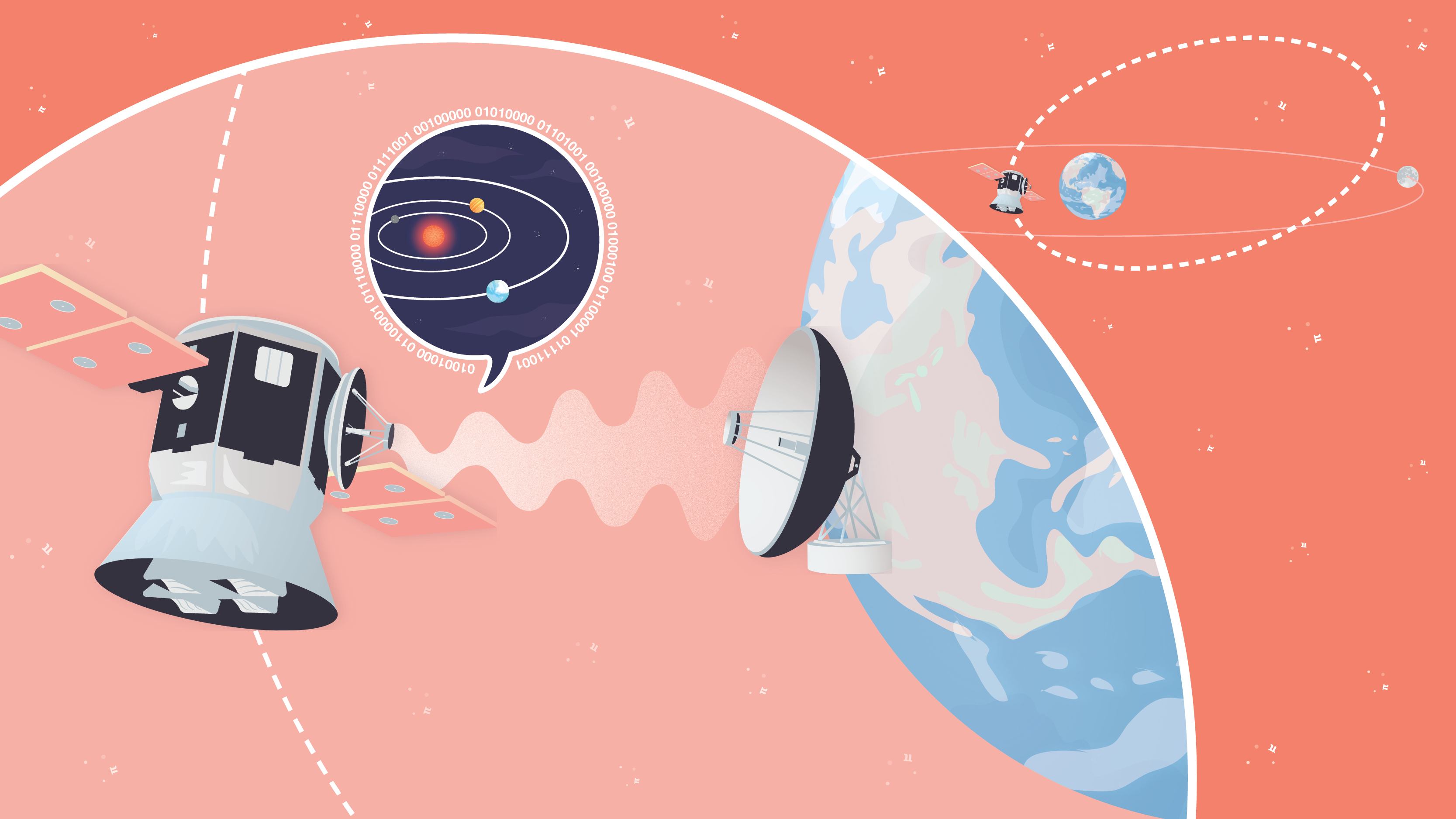
Pi in the Sky Lessons
Find everything you need to bring the NASA Pi Day Challenge into the classroom, including printable handouts of each illustrated math problem.
Grades 4-12
Time Varies
Articles
-
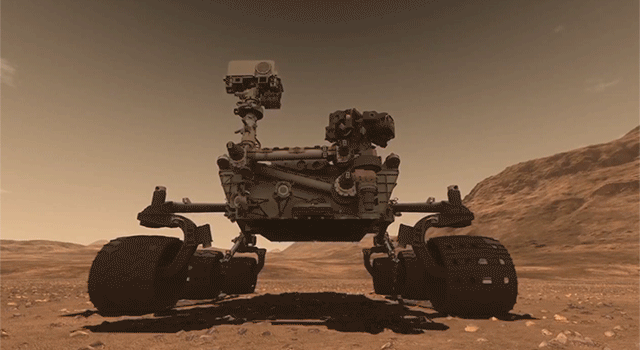
18 Ways NASA Uses Pi
Whether it's sending spacecraft to other planets, driving rovers on Mars, finding out what planets are made of or how deep alien oceans are, pi takes us far at NASA. Find out how pi helps us explore space.
-
10 Ways to Celebrate Pi Day With NASA on March 14
Find out what makes pi so special, how it’s used to explore space, and how you can join the celebration with resources from NASA.
Multimedia & Downloads
Recursos en español
TAGS: Pi, Pi Day, Dawn, Voyager, Engineering, Science, Mathematics
Teachable Moments | April 19, 2017
How NASA Studies and Tracks Asteroids Near and Far
In the News
On April 19, an asteroid named 2014 JO25 will safely fly by Earth, passing at a distance of about 1.1 million miles (1.8 million kilometers) of the planet. This asteroid poses no threat to Earth and, in fact, asteroids safely fly by Earth quite regularly. What makes the upcoming close approach of asteroid 2014 JO25 unique is that it is a rather large asteroid, measuring about 2,000 feet (more than 600 meters) across. The last time an asteroid that large, or larger, came that close to Earth was in 2004. Not much is known about asteroid 2014 JO25 other than its approximate size, its trajectory (or path around the sun) and that its surface is about twice as reflective as that of the moon. When it passes by, the asteroid will be bright enough that small optical telescopes can be used to spot it in the night sky. Scientists around the world will also study the asteroid with telescopes to determine its composition and rotation and with radar that could reveal small surface features.
Asteroid Resources for Educators
Explore our collection of standards-aligned lessons all about asteroids!
Why It's Important
Asteroids are some of what remains of the material that formed our solar system about 4.6 billion years ago. Unchanged by the forces that have altered rocks on our home planet, the moon, Mars and other destinations around the solar system, asteroids provide a glimpse into what conditions were like when our solar system took shape. Studying the chemical and physical properties, as well as the location and motion of asteroids, is vital to helping us understand how the sun, planets and other solar system bodies came to be.
The study of asteroids is so important, in fact, that NASA has sent several spacecraft to study some of these objects up close. For example, in 2007, the Dawn mission was sent to explore the two largest objects in the asteroid belt, Vesta and Ceres. Dawn arrived at the giant protoplanet Vesta in 2011 and orbited it for about one year before flying to the dwarf planet Ceres, which it continues to orbit and study today. Data from the Dawn mission showed Vesta to be a fascinating world more closely related to terrestrial planets than to typical asteroids and revealed clues that indicate there is a large amount of ice and maybe subsurface liquid water on Ceres. In 2016, NASA launched a spacecraft called OSIRIS-REx, which is headed for an asteroid called Bennu. When it arrives in August 2018, OSIRIS-REx will map the asteroid and collect a sample to return to Earth.
But there is another reason studying asteroids and their movements is important: detecting nearby asteroids and predicting any hazard they might pose to Earth.

This graphic shows the orbits of all the known "potentially hazardous asteroids," numbering over 1,400 as of early 2013. Being classified as a potentially hazardous asteroid does not mean that an asteroid will impact Earth. None of these asteroids depicted is a worrisome threat over the next hundred years. By continuing to observe and track these asteroids, their orbits can be refined and more precise predictions made of their future close approaches and impact probabilities. Image credit: NASA/JPL-Caltech | › Full image and caption
Both 2014 JO25 and Bennu are considered near-Earth objects, meaning their orbits bring them closer than 1.3 astronomical units (AU) from the sun. For comparison, Earth is 1 AU from the sun, or about 93,000,000 miles (150,000,000 kilometers). Also, both asteroids are classified as “potentially hazardous.” A potentially hazardous asteroid is one with an orbit that comes within 0.05 AU (about 4,650,000 miles or 7,480,000 km) of Earth’s orbit and has an absolute magnitude, a measure of brightness, of 22 or less. (On the magnitude scale, the lower the number, the brighter the object.) Absolute magnitude can be an indicator of size, so in other words, potentially hazardous asteroids are large – typically larger than about 500 feet (140 meters) across – and could get close to Earth. Having a designation of “potentially hazardous” does not necessarily indicate the object is a threat to Earth. Scientists use the classification to indicate an object deserves increased attention.
Out of more than 730,000 known asteroids, about 16,000 are near-Earth objects, and there are currently 1,784 potentially hazardous asteroids. But the risks of a large asteroid like 2014 JO25 or Bennu impacting Earth are exceedingly rare. And thanks to the Center for Near Earth Object Studies, or CNEOS, at NASA’s Jet Propulsion Laboratory, we have a very good understanding of where many of these asteroids are and where they are headed. Supporting NASA’s Planetary Defense Coordination Office, CNEOS continually uses new data acquired by telescopes and submitted to the Minor Planet Center to update orbit calculations, analyzes asteroid impact risks over the next century and provides data for every near-Earth object.
How It Works

This animated gif shows asteroid 2013 MZ5 as seen by the University of Hawaii's PanSTARR-1 telescope. The asteroid moves relative to a fixed background of stars. Asteroid 2013 MZ5 is in the right of the first image, towards the top, moving diagonally left/down. Image credit: PS-1/UH
Detecting near-Earth objects, or NEOs, is done by comparing multiple images, taken several minutes apart, of the same region of the sky. The vast majority of the objects appearing in these images are stars and galaxies, and their positions are fixed in the same relative position on all the images. Because a moving near-Earth object would be in a slightly different position on each image while the background stars and galaxies are in the same positions, it can be easy to identify the moving target if it is bright enough.
Surveys done by NASA-supported ground-based telescopes – including Pans-STARRS1 in Maui, Hawaii, as well as the Catalina Sky Survey near Tucson, Arizona – have identified thousands of near-Earth objects. And a space-based telescope called NEOWISE has identified hundreds of others while scanning the skies at near-infrared wavelengths of light from its polar orbit around Earth. Many ground-based telescopes perform follow-up observations to further aid in orbit calculations and to study the physical properties of the objects.
Once a near-Earth object is detected, its orbital characteristics are analyzed and astronomers determine if it is a potentially hazardous asteroid. This information is entered into CNEOS’ database, where it is continually updated and impact risks are monitored as new data becomes available.
Teach It
Asteroid 2014 JO25 won’t be this close for another 500 years, so now is a great opportunity to share this close approach with students and remind them that while it’s a close encounter by space standards, Earthlings need not be concerned. Try these standards-aligned lessons and activities with students:
- Grades 1-6: Whip Up a Moon-Like Crater - Use baking ingredients to whip up a moon-like crater as an asteroid-impact demonstration for students. This activity works in classrooms, camps and at home.
- Grades 3-5: Modeling an Asteroid - Students will shape their own asteroid models out of clay as a hands-on lesson in how asteroids form, what they are made of, and where they can be found in our solar system.
- Grades 8-12: Math Rocks: A Lesson in Asteroid Dynamics - Students use math to investigate a real-life asteroid impact.
- All ages: If you have a telescope, consider trying to view the asteroid at night. You’ll have to know where to look. Solar System Ambassador Eddie Irizarry shares how to find 2014 JO25 here. If you’re looking for more technical information about its location, use JPL’s Solar System Dynamics site to find the asteroid’s ephemeris.
Follow @AsteroidWatch on Twitter or visit the NASA Asteroid Watch website to find out more about upcoming close approaches.
Explore More
- Asteroids Facts & Figures - NASA Solar System Exploration
- Center for Near Earth Object Studies (CNEOS)
- NASA’s Planetary Defense Coordination Office
- Asteroid Watch
- Follow @AsteroidWatch on Twitter
- Goldstone Asteroid Radar Research
- Dawn Mission
- OSIRIS-REx Mission
TAGS: Asteroid Flyby, Asteroids, Near-Earth Objects, NEOs, Asteroid 2014 JO25, Dawn, OSIRIS-REx, NEOWISE, Asteroid TM
Edu News | March 9, 2015
Take the 2015 Pi Day Challenge!
UPDATE - March 16, 2015: The pi challenge answer key is now available for download.
In honor of the "Pi Day of the Century" (3/14/15), the Education Office at NASA's Jet Propulsion Laboratory has crafted another stellar math challenge to show students of all ages how NASA scientists and engineers use the mathematical constant pi.
The 2015 problem set -- available as a web infographic and printable handouts -- features four real-world, NASA math problems for students in grades 4 through 11, including: calculating the dizzying number of times a Mars rover's wheels have rotated in 11 years; finding the number of images it will take the Dawn spacecraft to map the entire surface of the dwarf planet Ceres (the first dwarf planet to be explored); learning the potential volume of water on Jupiter's moon Europa; and discovering what fraction of a radio beam from our most distant spacecraft reaches Earth.
The word problems, which were crafted by NASA/JPL education specialists with the help of scientists and engineers, give students insight into the real calculations space explorers use every day and a chance to see some of the real-world applications of the math they're learning in school.
"Pi in the Sky 2" Downloads:
- Poster - Download PDF (8 MB)
- Handouts - Download PDF (7 MB)
- Answers - Download PDF (8 MB)






